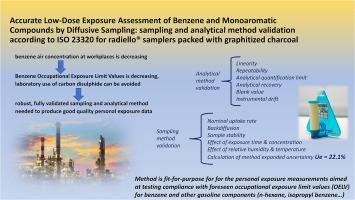Accurate low-dose exposure assessment of benzene and monoaromatic compounds by diffusive sampling: Sampling and analytical method validation according to ISO 23320 for radiello® samplers packed with graphitised charcoal and suitable for thermal desorption
IF 4.1
Q1 CHEMISTRY, ANALYTICAL
引用次数: 0
Abstract
This research was aimed at providing an accurate low-dose benzene exposure assessment method, prospectively suitable to exposure limit values in the low ppb range, such as in the present-day chemical, petrochemical, foundry and pharmaceutical industry. The project addresses the need for a robust and fully validated method of personal exposure measurements considering that the Occupational Exposure Limit Value for benzene will be significantly lowered in the next few years. Diffusive sampling offers a reliable alternative to pumped sampling methods, intrinsic safety in potentially explosive atmospheres, lightness and ease of use. The tested diffusive sampler is radiello® with the RAD145 adsorption substrate. This configuration is packed with graphitised charcoal suitable for thermal desorption and analysis by HRGC-FID or HRGC-MS.
The experiments have been conducted following the ISO 23320 standard in the range from 0.005 to 0.1 ppm (16 to 320 µg/m3), yielding a full validation of the sampling and analytical method. The sampler performances have fulfilled all requisites of the ISO 23320 standard, in particular: bias due to the selection of a non-ideal sorbent is lower than 10 % (no significant back diffusion of benzene due to concentration change in the atmosphere); bias due to storage of samples for up to 2 months is lower than 10 %; nominal uptake rate for benzene on RAD145 is 32.3 mL/min; expanded uncertainty of the sampling and analytical method is 22.1 % in the concentration range from 80 to 320 µg/m³. The sampling and analytical method is therefore fit-for-purpose for the personal exposure measurements aimed at testing compliance with lowered occupational exposure limit values for benzene. The method is also fit for short duration exposure monitoring related to specific tasks, and other volatile organic compounds, usually found in the same workplaces, such as aliphatic and aromatic hydrocarbons and some oxygenated compounds, have been also studied. In particular, n-hexane and isopropyl benzene (also known as cumene), whose classification is currently under revision, can be efficiently monitored by this technique.

通过扩散采样对苯和单芳香族化合物进行精确的低剂量暴露评估:根据 ISO 23320 标准对装有石墨化木炭并适合热脱附的 radiello® 采样器进行采样和分析方法验证
这项研究旨在提供一种准确的低剂量苯暴露评估方法,该方法有望适用于低 ppb 范围内的暴露限值,例如当今的化工、石化、铸造和制药行业。考虑到苯的职业接触限值将在未来几年内大幅降低,该项目需要一种可靠且经过充分验证的个人接触测量方法。扩散采样法是泵送采样法的可靠替代方法,在潜在爆炸性气体环境中具有内在安全性、轻便性和易用性。经过测试的扩散采样器是带有 RAD145 吸附基板的 radiello®。实验按照 ISO 23320 标准在 0.005 至 0.1 ppm(16 至 320 µg/m3)范围内进行,对采样和分析方法进行了全面验证。采样器的性能符合 ISO 23320 标准的所有要求,特别是:选择非理想吸附剂造成的偏差低于 10%(大气中的浓度变化不会导致苯的明显反向扩散);样品储存长达 2 个月造成的偏差低于 10%;RAD145 对苯的标称吸收率为 32.3 mL/min;在 80 至 320 µg/m³ 的浓度范围内,采样和分析方法的扩展不确定度为 22.1%。因此,该采样和分析方法适用于个人接触测量,旨在检测是否符合降低后的苯职业接触限值。该方法也适用于与特定任务相关的短时间暴露监测,而且还研究了通常在同一工作场所发现的其他挥发性有机化合物,如脂肪族和芳香族碳氢化合物以及一些含氧化合物。特别是,正己烷和异丙苯(又称 "积苯"),其分类目前正在修订中,可以通过这种技术进行有效监测。
本文章由计算机程序翻译,如有差异,请以英文原文为准。
求助全文
约1分钟内获得全文
求助全文

 求助内容:
求助内容: 应助结果提醒方式:
应助结果提醒方式:


